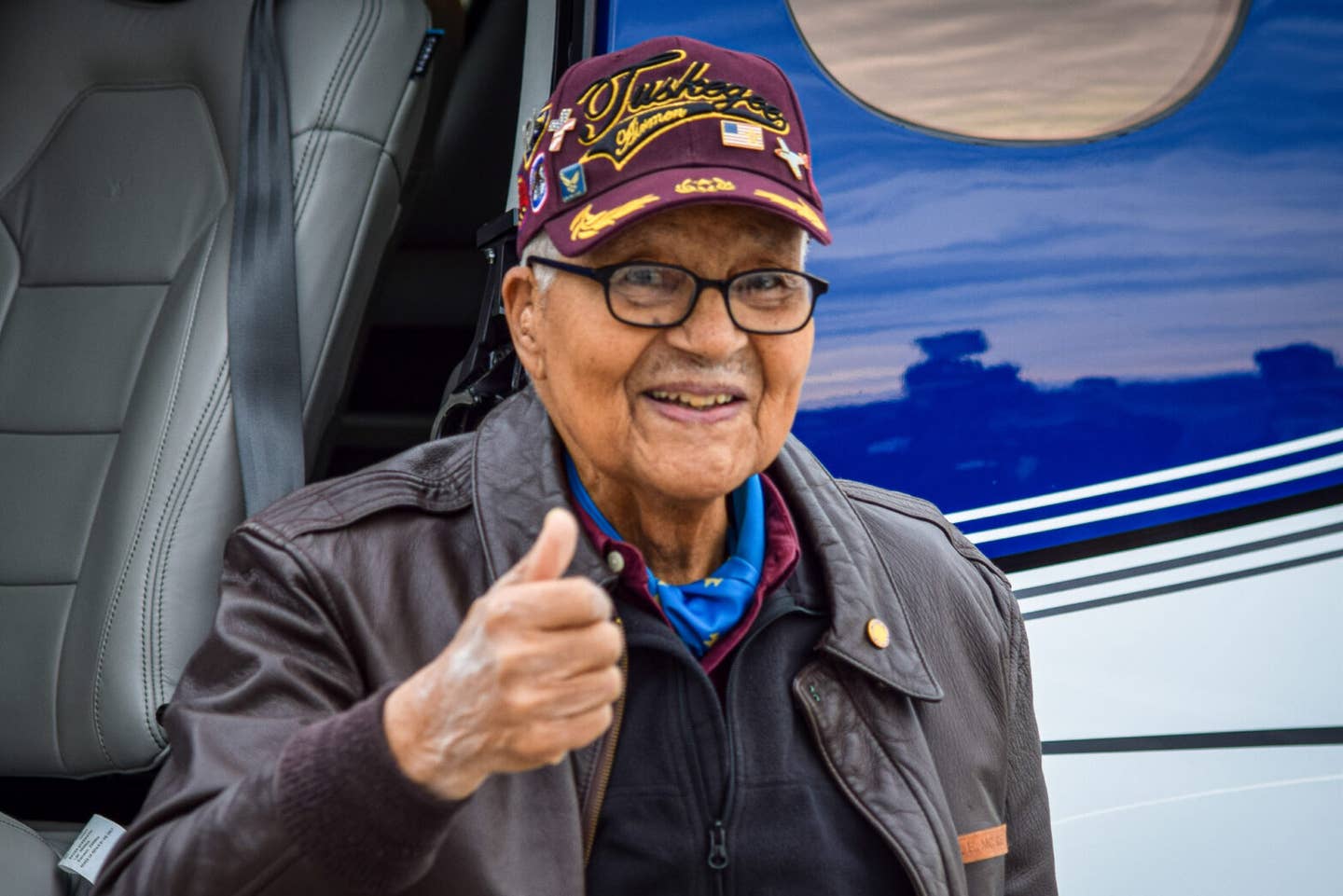Tuskegee Airman Charles McGee Dies at 102
Decorated Air Force pilot who flew over 400 fighter combat missions between World War II, the Korean War, and the Vietnam War passed away Sunday.

Brigadier General McGee gives a thumbs up after piloting a Cirrus Vision Jet with demo pilot Boni Caldeira, of Cirrus Aircraft to celebrate his 100th birthday. [Photo: Stephen Yeates]
Tuskegee Airman Brigadier General Charles McGee, the decorated Air Force pilot who flew over 400 fighter combat missions between World War II, the Korean War, and the Vietnam War, has died. He was 102.
According to his son, Ron McGee, his father died in his sleep Sunday at their home in Bethesda, Maryland.
Born in 1919, McGee spent most of his childhood moving around the U.S. until he graduated from a Chicago high school in 1938. McGee then went on to serve in the Civilian Conservation Corps to pay for his tuition at the University of Illinois.
Today, we lost an American hero. Charles McGee, Brigadier General and one of the last surviving Tuskegee Airman, passed at the age of 102. While I am saddened by his loss, I'm also incredibly grateful for his sacrifice, his legacy, and his character. Rest in peace, General. pic.twitter.com/3GLNbfRHs7
— Secretary of Defense Lloyd J. Austin III (@SecDef) January 16, 2022
After the attack on Pearl Harbor, McGee applied for a pilot’s slot in the experimental Black soldiers' flight program. Two days after marrying his wife, Frances, in 1942, he received orders to begin flight training at Tuskegee Army Air Field alongside other Black cadets.
As a member of the legendary Tuskegee Airmen, McGee went on to fly a total of 409 fighter combat missions, earning several commendations such as the Legion of Merit with Oak Leaf cluster, Distinguished Flying Cross with two clusters, and two Presidential Unit Citations.
McGee’s career took off when he graduated from flight school in June 1943. Then Second Lieutenant, he joined the all-Black 332nd Fighter Group in the 12th Air Force, flying P-39 Airacobras in Italy.
The 332nd Fighter Group was more famously known as the “Red Tails,” which garnered respect from their white counterparts and even the opposing German pilots. McGee made his journey back home in November 1944 with 136 missions to his name.
It wouldn’t be long before McGee had to serve once again, this time during the Korean War. In 1950, he flew out of Pusan with the 67th Fighter Bomber Squadron and flew 100 low-level bombing missions in his P-51 Mustang.
He eventually served as commander of the 44th Fighter Bomber Squadron and began flying the F-80 fighter jet. Three years later, McGee would graduate from the Air Command and Staff College at Maxwell Air Force Base. He then switched airframes once more, now flying the F-89 Scorpions.
In 1959, McGee was promoted to lieutenant colonel and spent a few years in Italy, North Dakota, and Missouri with his family. In 1967, he would be called to serve in his third conflict—the Vietnam War.
Flying RF-4C Phantoms, McGee led the 16th Tactical Reconnaissance Squadron from Tan Son Nhut Air Base on 173 missions. In an interview with Aviation History Magazine, he recounted one of his most dangerous missions.
“Late in 1967, I was flying a day recon mission over one of the roads in Laos. It was a suspected infiltration route, but I’d received no intelligence of heavy defenses. As I was letting down, however, I took a high-caliber hit in my left wing, which left a big hole. I was losing fluids, though I couldn’t tell which ones. I had to divert to the nearest base on the coast, Da Nang, and it was the only time I had to make a front-end engagement landing, using my tail hook to make sure we wouldn’t run off the runway,” he said.
When asked about his reaction to getting hit, McGee responded, “Well, the shooting got your adrenaline up—you’d put on more speed, which was about all you could do,” he said. “Was I scared? Our military training set us up with the idea that you’re trained to do a job. You were too busy to dwell on the danger while you performed. Hopefully, you would get home in one piece.”
McGee was then promoted to colonel in 1969 and assigned to the 1840th Air Base Wing as commander three years later. In January of 1973, McGee retired from the Air Force, having completed 30 years of service and setting the record for the most aerial fighter combat missions over three wars. He is fondly remembered by those he served with as a man who lived by his mantra: “Do while you can.”
We’re saddened by the loss of Brig. Gen. Charles McGee, a trailblazer who served as a Tuskegee Airman and flew 409 combat missions. Seen here in 2020, he encouraged the Artemis Generation to fly to new heights by applying to become an astronaut: pic.twitter.com/GBqgRBeNr5
— NASA (@NASA) January 16, 2022
McGee was awarded the Congressional Gold Medal by then President George W. Bush in 2007, alongside some of his fellow Tuskegee Airmen.
McGee served two terms as the national president of the Association of Tuskegee Airmen, leading efforts to provide aviation career opportunities for people of color.
Later in life, he was inducted into The National Aviation Hall of Fame in 2011, and in 2020, he was promoted to brigadier general.
He celebrated his 100th birthday with the 436th Airlift Wing by flying a Cirrus Vision Jet where, according to the Cirrus Aircraft demo pilot, he “maintained great situational awareness throughout the flight all the way to its conclusion.”

Sign-up for newsletters & special offers!
Get the latest FLYING stories & special offers delivered directly to your inbox






